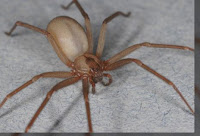World's most dangerous insects
Here is a list of the top 10 most dangerous insects in the world:
1. Mosquitoes:
Mosquitoes are carriers of diseases such as malaria, dengue, yellow fever,and Zika virus, causing millions of deaths each year.
2. Kissing Bugs:
Also known as Triatomine bugs, these insects carry Chagas disease, which affects millions of people in Latin America.
3. Africanized Honey Bees:
These highly aggressive bees are also known as "killer bees," and they can attack in large swarms, causing serious harm and even death to humans.
4. Japanese Giant Hornet:
The Japanese giant hornet has a potent venom that can cause multiple organ failure and death in humans.
5. Asian Giant Hornet:
Also known as the yak-killer hornet, these insects have a venomous sting that can cause severe pain, swelling, and even death in some cases.
6. Deathstalker Scorpion:
Found in the deserts of North Africa and the Middle East, the deathstalker scorpion's venom can cause severe pain, paralysis, and death in humans.
7. Cone Snails:
These snails have a venomous sting that can cause paralysis and death in humans, making them one of the most dangerous species of snails in the world.
8. Brown Recluse Spider:
The brown recluse spider is found in the southern and central United States, and its venom can cause necrosis, or tissue death, in humans.
9. Sydney Funnel-Web Spider:
Found in Australia, the Sydney funnel-web spider's venom can cause serious injury and death in humans, making it one of the most venomous spiders in the world.
10. Irukandji Jellyfish:
Found in the waters off the coast of Australia, the Irukandji jellyfish's venom can cause intense pain, heart problems, and death in humans.
It's important to note that while these insects can be dangerous, they can also be avoided with the proper precautions and treatments.
Here's more information on each of these insects:
1. Mosquitoes:
Mosquitoes are small, flying insects that feed on the blood of humans and other animals. They are carriers of diseases such as malaria, dengue, yellow fever, and Zika virus, which can cause serious health problems, including death. To avoid mosquito bites, it's important to use insect repellent, wear long sleeves and pants, and avoid being outside during peak mosquito hours.
2. Kissing Bugs:
Kissing bugs are blood-sucking insects that are found in the southern and central United States, as well as Central and South America. They get their name from their habit of biting humans near the mouth and eyes. Kissing bugs are carriers of Chagas disease, a serious condition that affects millions of people in Latin America and can cause heart problems, digestive problems, and death. To avoid kissing bugs, it's important to keep your living areas clean and free of food and water sources and to use insecticide when necessary.
3. Africanized Honey Bees:
Africanized honey bees are a hybrid species of honey bee that are highly aggressive and known to attack humans in large swarms. These bees are found in South and Central America, as well as the southern United States. To avoid Africanized honey bees, it's important to avoid disturbing hives and to stay away from flowering plants and trees that may attract the bees. If you encounter a swarm of Africanized honey bees, it's important to run away as quickly as possible and seek shelter.
4. Japanese Giant Hornet:
The Japanese giant hornet is the largest hornet species in the world and is known for its potent venom that can cause multiple organ failure and death in humans. These insects are found in Japan and parts of China and South Korea. To avoid Japanese giant hornets, it's important to avoid their nests and to wear protective clothing, such as long sleeves and pants, when working or hiking in areas where these insects are found.
5. Asian Giant Hornet:
The Asian giant hornet is a large species of hornet that is known for its aggressive behavior and venomous sting. These insects are found in parts of Asia, including Japan and China, and can cause severe pain, swelling, and even death in some cases. To avoid Asian giant hornets, it's important to avoid their nests and to wear protective clothing, such as long sleeves and pants, when working or hiking in areas where these insects are found.
6. Deathstalker Scorpion:
The deathstalker scorpion is a venomous species of scorpion that is found in the deserts of North Africa and the Middle East. Their venom can cause severe pain, paralysis, and death in humans, making them one of the most dangerous species of scorpions in the world. To avoid deathstalker scorpions, it's important to shake out your shoes and clothing before putting them on and to be cautious when walking in areas where these insects are found.
7. Cone Snails:
Cone snails are a type of sea snail that is found in the waters off the coast of Australia, the Caribbean, and the Pacific. These snails have a venomous sting that can cause paralysis and death in humans, making them one of the most dangerous species of snails in the world. To avoid cone snails, it's important to be careful when swimming in areas where these snails are found and to always wear protective footwear when walking in shallow water.
8. Brown Recluse Spider:
The brown recluse spider is a venomous species of spider that is found in the southern and central United States. Its venom can cause necrosis, or tissue death, in humans.
9. Sydney Funnel-Web Spider:
Found in Australia, the Sydney funnel-web spider's venom can cause serious injury and death in humans, making it one of the most venomous spiders in the world.
10. Irukandji Jellyfish:
Found in the waters off the coast of Australia, the Irukandji jellyfish's venom can cause intense pain, heart problems, and death in humans.
It's important to note that while these insects can be dangerous, they can also be avoided with the proper precautions and treatments.












0 Comments